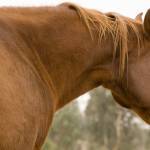Sweeney in Horses: What Is It?

“Sweeney” isn’t a term most modern horse owners hear frequently, if at all, but a century ago when horses were driven more often, it was a common malady.
Sweeney refers to a hollowed area just below and to the rear of the horse’s shoulder line. The condition is due to muscle wasting after the suprascapular nerve has been damaged. This nerve controls the shoulder muscles that allow the horse to swing its leg forward. The muscle tissues atrophy from lack of use and a depression appears where the muscle has wasted.
In the age of horsepower, horses were subject to nerve damage from poorly fitting collars that pressed against the shoulders, and sweeney was a fairly frequent ailment that often limited or ended a horse’s productive years. Today the injury is more commonly caused by a kick from another horse or from the horse running its shoulder into a tree, fence post, or the edge of a stall door opening. Diagnosis may include radiographs to rule out a fracture of the shoulder blade.
The initial injury causes pain, inflammation, and lameness. The horse may be reluctant to move, and will walk with difficulty when forced to take a step. Early treatment is aimed at reducing pain and inflammation, both to make the horse more comfortable and to encourage as much movement as possible. A controlled exercise program, physical therapy, and electrostimulation can keep the muscles somewhat active and limit atrophy. Up to twelve months may be necessary for the nerve to recover full function.
For horses that don’t improve with this treatment, another option is surgery to remove a small amount of bone and scar tissue, decompressing the nerve and allowing it to heal. This procedure may result in an increased risk of scapular (shoulder blade) fracture because the bone has been weakened, though this risk decreases as healing continues.
About 80% of horses with injury to the suprascapular nerve will see improvement in foreleg function without surgery. However, the chance of returning to the previous level of performance is limited if significant atrophy has occurred.








